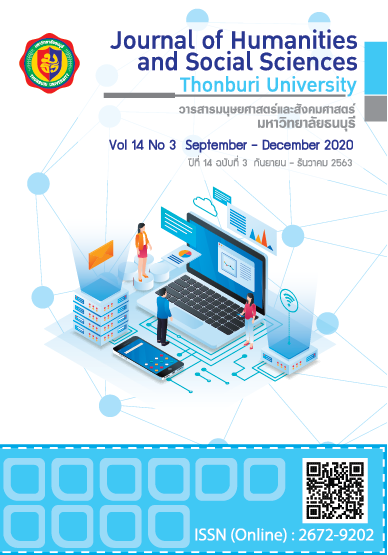The participation process for preventingCOVID19: A case study of active aging in Nhong Ta Go community
Keywords:
aging society, participation, COVID19, AgingAbstract
Abstract
This participatory action research aimed to describe the participation process of the elderly, and its outcomesfor supporting the prevention process of COVID19 diseases at Nhong Ta Go community. The research conducted in March, 2020. These 24 research participants were the elderly clubsleaders and the elderly club members, academic research technicians, and the community members. Data were collected by participating observation, non-structural interview, field-notes, photographic memoires; and analyzed by content analysis. The results showed that the elderly participation process could be staged by 4 steps. There are the Plan step, the Do step, the Check step and the Act step. The impact of participatory process were the unity and solidarity of the elderly club, elderly’s happiness, the club’s networks, the volunteers’system for community development, the club’s leaders’ self-efficacy, and the conflict management capacity of the participants. The elderlyparticipation process was not only the social relationship,but it was also the elderly value added process to contribute to this aging society. The social should reconsider (1) its perception toward the elderly as well as (2) the value given to the elderly by supporting the elderly’s activities and actions for public benefits.
Keywords: Aging, Aging society, Participation, COVID19
References
กรมควบคุมโรค. (2562).โรคติดเชื้อไวรัสโคโรนา 2019. สืบค้นเมื่อ 13 เมษายน 2563, จากhttps://ddc.moph.go.th/ viralpneumonia
กิติพัฒน์ นนทปัทมดุลย์. (2554). การวิจัยเชิงคุณภาพในสวัสดิการสังคม: แนวคิดและวิธีวิจัย. พิมพ์ครั้งที่ 2. กรุงเทพฯ: สำนักพิมพ์มหาวิทยาลัยธรรมศาสตร์.
ประเวศ วะสี. (2542).ชุมชนเข้มแข็ง ทุนทางสังคมของไทย: หนังสือชุดชุมชนเข้มแข็ง ลำดับที่1. กรุงเทพฯ: สำนักงานกองทุนเพื่อสังคม ธนาคารออมสิน.
วันชัย วัฒนศิริ. (2546). ความคิดเห็นเกี่ยวกับผลกระทบทางเศรษฐกิจ สังคมและสิ่งแวดล้อมจากการก่อสร้างขยายทางหลวงแผ่นดิน หมายเลข 3 (สุขุมวิท) ที่มีต่อประชาชน 2 ข้างทาง.มหาวิทยาลัยบูรพา:ชลบุรี.
สถาบันวิจัยประชากรและสังคม มหาวิทยาลัยมหิดล. (2563). มิเตอร์ประเทศไทย. สืบค้นเมื่อ 13 เมษายน 2563, จาก http://www.thailandometers.mahidol.ac.th
สมบัติ ธำรงธัญญวงศ์.(2546). นโยบายสาธารณะ. พิมพ์ครั้งที่ 10. กรุงเทพฯ: สถาบันบัณฑิตพัฒนบริหารศาสตร์.
สมศักดิ์ ศรีสันติสุข.(2552). สังคมวิทยาสุขภาพ.ขอนแก่น: คณะมนุษยศษสตร์และสังคมศาสตร์ มหาวิทยาลัยขอนแก่น.
สุภางค์ จันทวานิช. (2551). ทฤษฎีสังคมวิทยา. กรุงเทพฯ: สำนักพิมพ์แห่งจุฬาลงกรณ์.
อคิน รพีพัฒน์, ม.ร.ว. (2536). การศึกษาและวิเคราะห์ชุมชนในการวิจัยเชิงคุณภาพ. ใน อุทัยดุลยเกษม, บรรณาธิการ. คู่มือการวิจัยเชิงคุณภาพเพื่องานพัฒนา. ขอนแก่น: สถาบันวิจัยและพัฒนา มหาวิทยาลัยขอนแก่น.
อานันท์ กาญจนพันธ์.(2559).ทุนทางสังคมกับการพัฒนาเมือง. กรุงเทพฯ: สำนักงานกองทุนสนับสนุนการสร้างเสริมสุขภาพ.
Bracth, N. ; & Tsouros, A. (1990). Principles and strategies of effective community participation. Health Promotion International, 5(3): 199-208.
Deming, W. E. (1986). W. Edwards Deming. Retrieved April 13, 2020, from http://www.agileleanhouse.com/lib/ AgileLeanLibrary/People/WEdwardsDeming/WikipediaDeming.pdf
Eilers, K.M., Lucey, A.P. & Stein, S.S. (2007). "Promoting social capital for the elderly. Nursing Economics, 25(5): 304-309.
Holmes, R.W.; & Joseph, J. (2011). Social participation and healthy ageing: a neglected, significant protective factor for chronic non communicable conditions. Globalization and Health 2011. Retrieved April 13, 2020, from http://www.globalizationandhealth.com/content/7/1/43
Lu,L., Kao,F.S., & Hsieh, H.Y. (2009). Positive Attitudes toward Older People and Well-being among Chinese Community Older Adults. Journal of Applied Gerontology, 29(5): 622–639.
Tahara Yoshio. (2016). Cardiopulmonary Resuscitation in a Super-Aging Society-Is There an Age Limit for Cardiopulmonary Resuscitation?. Circulation Journal, 80: 1102-1103.
WHO. (2002). Active Aging A Policy Framework. Geneva: Who.
Translated Thai References
Department of Diseases Control. (2019). Thailand.COVID-19. Retrieved April 13, 2020, from https://ddc. moph.go.th/viralpneumonia/ (in Thai)
Institute for Population and Social Research, Mahidol University.(2020). Thailandometers. Retrieved April 13, 2020, from http://www.thailandometers.mahidol.ac.th (in Thai)
Janthavanich, S. (2008). Sociology theories. Bangkok: Chulalongkorn University press. (in Thai)
Kanjanaphan, A.(2016). Social capital and urban development. Bangkok. Thailand foundation of Health promotion. (in Thai)
Nonthapatthamadul, K. (2011). Qualitative research in social affaire: Concept and Methodology. 2nded. Bangkok: Thammasart University press. (in Thai)
Rapeepath, A.(1993). Community study and analyze in qualitative research cite in the handbook of qualitative for development. UthaiDoolyakasem, Editors. KhonKean: Institute of research and development, Khon Kean University.
Srisantisook, S. (2009). Sociology of health. KhonKean : Faculty of humanity and social science, Khon Kean University. (in Thai)
Thamrongthanyawong, S. (2003). Public policy. 10thed. Bangkok: National Institute of development Administration. (in Thai)
Wasee, P. (1999). Strengthen community social capital of Thai society: the 1st book for strengthen community. Bangkok: the office of fund for societies, Government saving bank. (in Thai)
Watthanasiri, W.(2003). The opinion about economic social and environment impact from the highway no3 (Sukumvit) expansion in habitats along the ways .Chonburi: Burapha University (in Thai)







